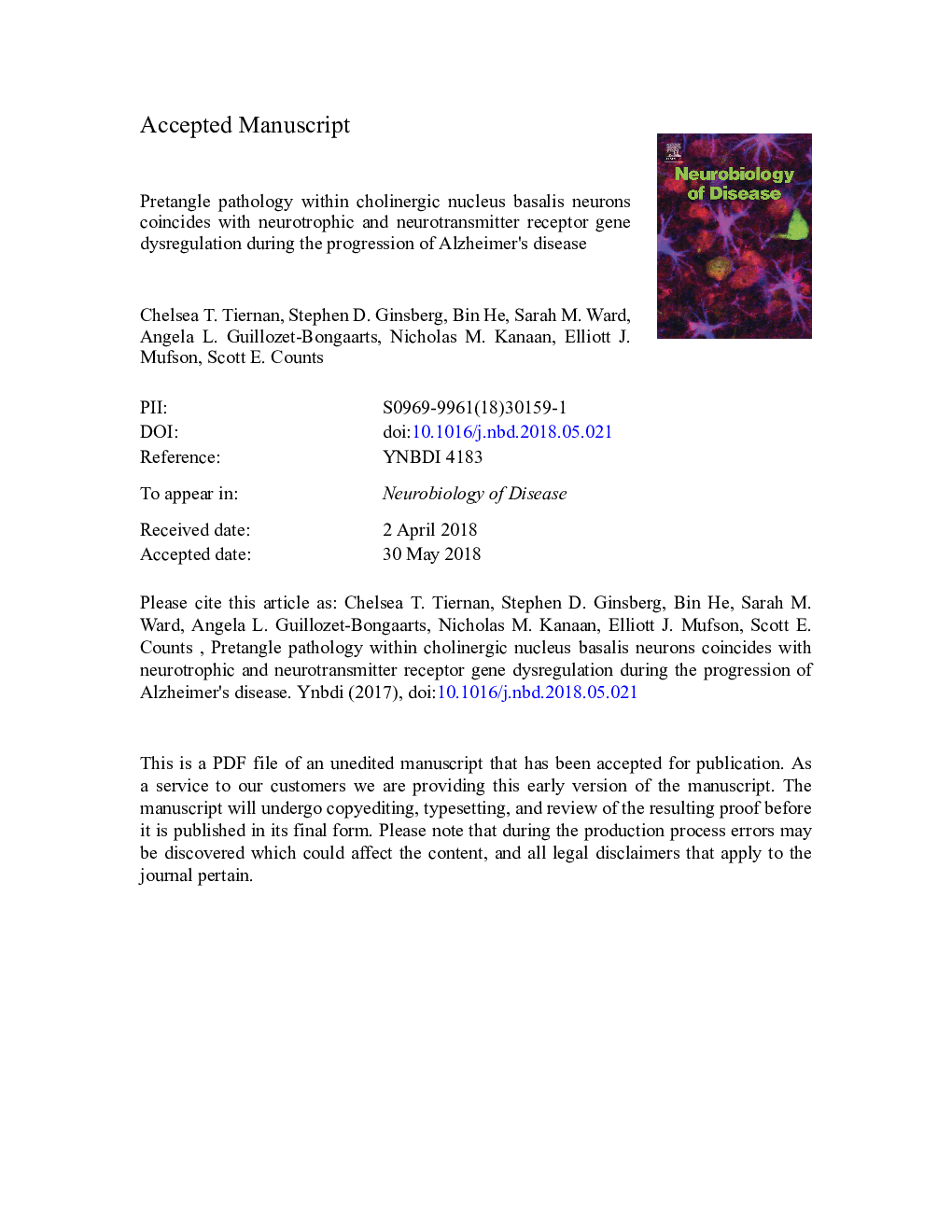| کد مقاله | کد نشریه | سال انتشار | مقاله انگلیسی | نسخه تمام متن |
|---|---|---|---|---|
| 8686329 | 1580603 | 2018 | 56 صفحه PDF | دانلود رایگان |
عنوان انگلیسی مقاله ISI
Pretangle pathology within cholinergic nucleus basalis neurons coincides with neurotrophic and neurotransmitter receptor gene dysregulation during the progression of Alzheimer's disease
ترجمه فارسی عنوان
پاتولوژی پراکندگی در هسته های کولینرژیک بازالیس نورون ها با تغییرات ژن گیرنده نوروپاتیک و نوروترانسمیتر در طول پیشرفت بیماری آلزایمر
دانلود مقاله + سفارش ترجمه
دانلود مقاله ISI انگلیسی
رایگان برای ایرانیان
کلمات کلیدی
PI3KCERADadrenoceptorNFTPLCγNT-3cdk5NBMGCsAkt1CREB1MMSEBChENGFbutyrylcholinesteraseHTR1BGABBR1ECDConsortium to Establish a Registry for Alzheimer's DiseaseJnkNCIBDNF - BDNF یا فاکتور نورونزایی مشتقشده از مغز c-Jun N-terminal kinase - C-Jun N-terminal kinaseAChE - آهیApoe - آپوapolipoprotein E - آپولیپوپروتئین Emild cognitive impairment - اختلال شناختی خفیفAcetylcholinesterase - استیل کولین استرازMini-mental state exam - امتحان وضعیت مینی روانیNeurotransmission - انتقال عصبیAlzheimer's disease - بیماری آلزایمرvesicular acetylcholine transporter - حمل کننده استیل کولین vesicularNeurofibrillary tangle - خلط نوروفیبریلاextracellular domain - دامنه خارج سلولیcyclin-dependent kinase 5 - سیکلین وابسته به کیناز 5brain derived neurotrophic factor - عامل مغز استخوان مغز استخوان استnerve growth factor - فاکتور رشد عصبphosphatidylinositol 3 kinase - فسفاتیدیلینوزیتول 3 کینازphospholipase C-γ - فسفولیپاز C-γNeurotrophin - نوروتروفینneurotrophin-3 - نوروتروفین-3nucleus basalis of Meynert - هسته پایه MeynertMCI - همراه اولcholinergic basal forebrain - پیشانی بازال کولینرژیکChAT - چتcholine acetyltransferase - کولین استیل ترانسفرازTrk receptor - گیرنده Trkacetylcholine receptor - گیرنده استیل کولینDopamine receptor - گیرنده دوپامینnerve growth factor receptor - گیرنده فاکتور رشد عصبیGlutamate receptor - گیرنده گلومات
موضوعات مرتبط
علوم زیستی و بیوفناوری
علم عصب شناسی
عصب شناسی
چکیده انگلیسی
Cholinergic basal forebrain neurons of the nucleus basalis of Meynert (nbM) regulate attentional and memory function and are exquisitely prone to tau pathology and neurofibrillary tangle (NFT) formation during the progression of Alzheimer's disease (AD). nbM neurons require the neurotrophin nerve growth factor (NGF), its cognate receptor TrkA, and the pan-neurotrophin receptor p75NTR for their maintenance and survival. Additionally, nbM neuronal activity and cholinergic tone are regulated by the expression of nicotinic (nAChR) and muscarinic (mAChR) acetylcholine receptors as well as receptors modulating glutamatergic and catecholaminergic afferent signaling. To date, the molecular and cellular relationships between the evolution of tau pathology and nbM neuronal survival remain unknown. To address this knowledge gap, we profiled cholinotrophic pathway genes within nbM neurons immunostained for pS422, a pretangle phosphorylation event preceding tau C-terminal truncation at D421, or dual-labeled for pS422 and TauC3, a later stage tau neo-epitope revealed by this same C-terminal truncation event, via single-population custom microarray analysis. nbM neurons were obtained from postmortem tissues from subjects who died with an antemortem clinical diagnosis of no cognitive impairment (NCI), mild cognitive impairment (MCI), or mild/moderate AD. Quantitative analysis revealed significant downregulation of mRNAs encoding TrkA as well as TrkB, TrkC, and the Trk-mediated downstream pro-survival kinase Akt in pS422+ compared to unlabeled, pS422-negative nbM neurons. In addition, pS422+ neurons displayed a downregulation of transcripts encoding NMDA receptor subunit 2B, metabotropic glutamate receptor 2, D2 dopamine receptor, and β1 adrenoceptor. By contrast, transcripts encoding p75NTR were downregulated in dual-labeled pS422+/TauC3+ neurons. Appearance of the TauC3 epitope was also associated with an upregulation of the α7 nAChR subunit and differential downregulation of the β2 nAChR subunit. Notably, we found that gene expression patterns for each cell phenotype did not differ with clinical diagnosis. However, linear regression revealed that global cognition and Braak stage were predictors of select transcript changes within both unlabeled and pS422+/TauC3â neurons. Taken together, these cell phenotype-specific gene expression profiling data suggest that dysregulation of neurotrophic and neurotransmitter signaling is an early pathogenic mechanism associated with NFT formation in vulnerable nbM neurons and cognitive decline in AD, which may be amenable to therapeutic intervention early in the disease process.
ناشر
Database: Elsevier - ScienceDirect (ساینس دایرکت)
Journal: Neurobiology of Disease - Volume 117, September 2018, Pages 125-136
Journal: Neurobiology of Disease - Volume 117, September 2018, Pages 125-136
نویسندگان
Chelsea T. Tiernan, Stephen D. Ginsberg, Bin He, Sarah M. Ward, Angela L. Guillozet-Bongaarts, Nicholas M. Kanaan, Elliott J. Mufson, Scott E. Counts,
